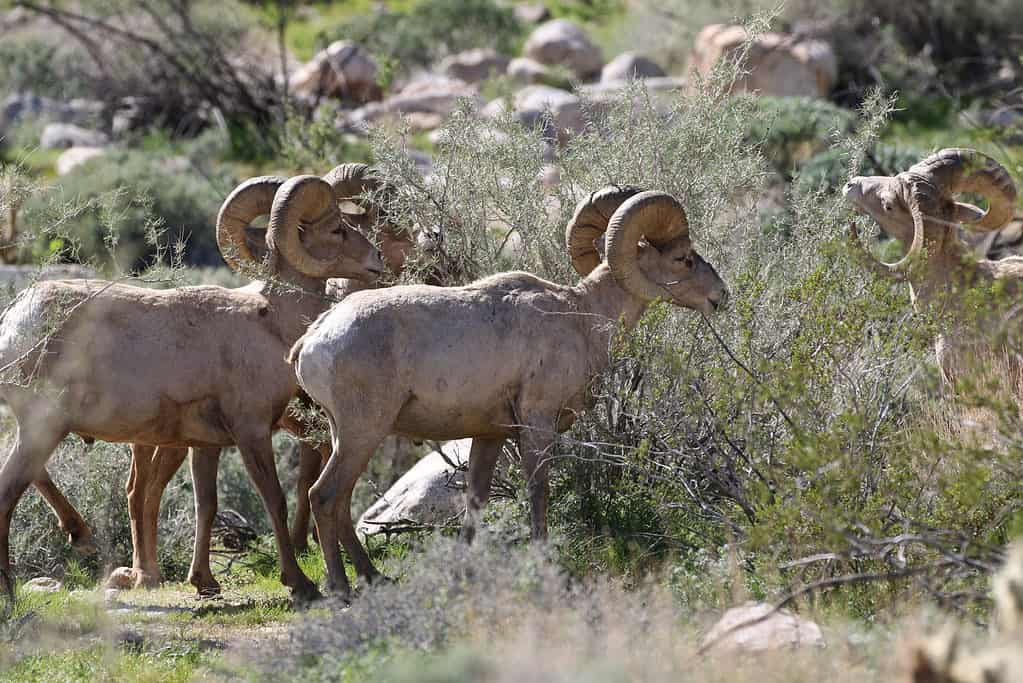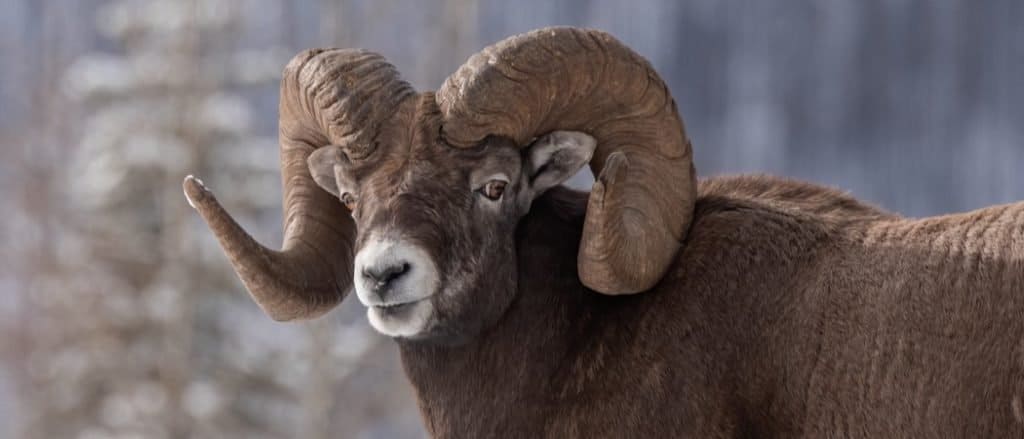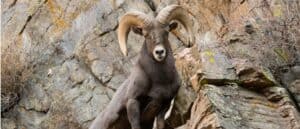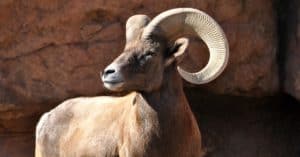If you are ever visiting the mountainous and beautiful state of Idaho, you can’t leave without sneaking a peak at the iconic bighorn sheep that call Idaho home. Sadly, the bighorn sheep population is decreasing because of diseases. Still, they are popular amongst hunters since you need a controlled hunt tag and there are only 85. If accepted, you can only harvest one California and one Rocky Mountain bighorn sheep in your lifetime.
About The Bighorn Sheep
Bighorn sheep are native to North America. They get their names from their large horns. Bighorn sheep are thought to be originally from Siberia but crossed the Bering Land Bridge to North America. There are three subspecies, however, one is endangered. In North America, there used to be millions of bighorn sheep at its peak, however, now there are only thousands.

Bighorn sheep get their name from their large horns.
©Randy Bjorklund/Shutterstock.com
Appearance And Size
Male bighorn sheep have large curved horns, while female sheep have smaller horns with less curvature. Their coats are typically white, brown, or gray. Interestingly, male bighorns have adaptations that help them survive and withstand heavy impacts. Bighorn sheep range in size and weight, however, an average male bighorn sheep weighs between 128 to 315 pounds. While this is true, bighorn sheep living in the Rocky Mountains are larger than those living in Nevada, males can sometimes surpass 500 pounds. Female bighorn sheep are slightly smaller, weighing about 75 to 200 pounds. The smallest bighorn sheep by region is the Sierra Nevada bighorn, which barely weighs past 198 pounds.

Male bighorn sheep have large curved horns, while female sheep have smaller horns with less curvature.
©iStock.com/Rainbohm
Diet
Bighorn sheep are grazers. They mainly eat grass and shrubs. However, the exact plants they eat vary from region to region. Still, during winter, bighorn sheep need more minerals and look for saltlicks. While female bighorn sheep graze, they also walk which protects them from predators.
Predators
These mountain-loving sheep have many predators including black bears, grizzly bears, mountain lions, and wolves. However, young bighorn sheep are the most vulnerable to predators. These small sheep are hunted by coyotes, bobcats, golden eagles, lynxes, ocelots, and jaguars. When running and hiding from a predator, bighorn sheep climb steep terrain and look for hard-to-reach places.
The Largest Bighorn Sheep Ever Caught In Idaho
Bighorn sheep can grow very large. The largest bighorn sheep ever caught in Idaho scored 201 5/8. In 2016, Gary J. Sublett caught a large record-breaking bighorn sheep in an area called Hells Canyon. He still owns the horns. Three years later, another lucky and skilled hunter, Douglas A. Sayer nearly broke the record with his 200 1/8 catch.

The largest bighorn sheep ever caught in Idaho was in 2016 by Gary J. Sublett scoring 201 5/8.
©Harry Collins Photography/Shutterstock.com
The Largest Bighorn Sheep Ever Caught In The World
The same year that the largest bighorn sheep was caught in Idaho, the largest bighorn sheep in the world was found in Montana. This area in Montana seems to be where most of the large bighorn sheep reside, especially since three of the top 5 records were found or caught in Lake County. The largest bighorn sheep in the world was found and scored 216 4/8. Currently, the owner of this impressive find is the Montana Dept. of Fish, Wildlife & Parks.
Where Is Hells Canyon, Idaho Located On A Map?
Hells Canyon, the deepest gorge in North America, forms part of the Idaho-Oregon border and is in the Nezperce and Payette National Forests area, which is in the northwest region of Idaho. Idaho is located in the Pacific Northwest region of the United States. It is bordered by Washington and Oregon to the west, Montana and Wyoming to the east, Utah and Nevada to the south, and the Canadian Province of British Columbia to the north.
Common Animals In Idaho
Idaho has one of the most diverse wildlife and environments in the United States. There are at least 300 species of animals and over 100 species of fish. Listed below are some of the most common animals in Idaho.
American Bison
American bison are found year-round in Idaho. They are very common in Yellowstone National Park. American bison are very large and look similar to buffalos. They can weigh between 880 and 2,800 pounds. American bison are also tall, adults stand at 6 feet and 7 inches. European bison are taller, but weigh less on average. These large animals are ruminants and eat a wide variety of plants.

American bison are found year-round in Idaho and can weigh between 880 and 2,800 pounds.
©Tim Malek/Shutterstock.com
Common Yellowthroat
Common yellowthroats are pretty and small yellow birds. They are common in Idaho throughout spring. These tiny birds weigh about 0.34 ounces. They are nicknamed the yellow bandit and can be found from southern Canada to central Mexico. Common yellowthroats have many predators, frequently falling prey to other carnivorous birds. They are quick birds. Female common yellowthroats build their nests in 4 to 5 days. However, some yellowthroats have been observed building their nests in as little as 2 days.
Milk Snake
Milk snakes are one of the most common snakes in North America. There are about 24 subspecies. Many of these snakes are bright and colorful with rings or stripes around their bodies. Milk snakes are about 2 to 3 feet long. Some subspecies are taken as pets. In a controlled environment as a pet, they can live over 20 years. However, milk snakes have a 15-year lifespan in the wild. Milk snakes are nonvenomous, but often mistaken for copperheads or coral snakes.
Black-tailed Jackrabbit
Another common animal in Idaho is the black-tailed jackrabbit. They are the most common in the western United States and Mexico. Most black-tailed jackrabbits are about 2 feet long and weigh 3 to 6 pounds. While this might sound small, they are one of the largest North American hares. Black-tailed jackrabbits don’t migrate or hibernate. Instead, they stay in their homes all year round. They are quick and run from predators, but also have many predators, like hawks.
The photo featured at the top of this post is © Georgia Evans/Shutterstock.com
Thank you for reading! Have some feedback for us? Contact the AZ Animals editorial team.





